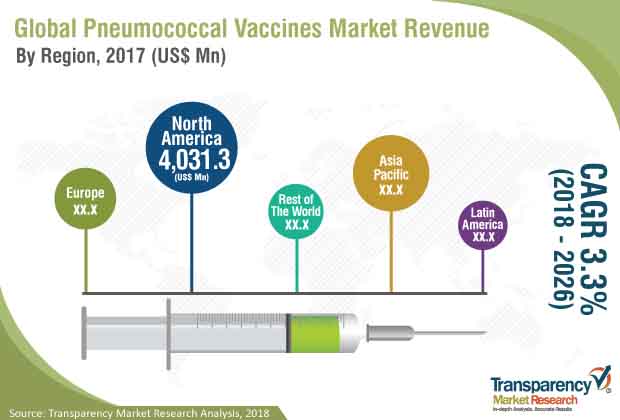Pneumococcal Vaccines Market to reach US$ 9,768.8 mn by 2026 – TMR
Global Pneumococcal Vaccines Market – Snapshot
Vaccination is one of the most cost-effective and safest ways to prevent diseases. Pneumococcus is one of the major causes of blood infection, pneumonia, sinusitis, meningitis, and otitis media. It is also a leading infectious disease. However, it can be prevented with the help of vaccination. Majority of countries have pneumococcal vaccines in their national immunization program for children aged under 1 year. Increase in pneumococcal diseases due to causative serotype drives the need for vaccines with broader coverage. Hence, demand for new pneumococcal vaccines with wider serotype coverage is rising.
Request Sample Of Report – https://www.transparencymarketresearch.com/sample/sample.php?flag=S&rep_id=52146

Despite the availability of antibiotic therapy against pneumococcal disease, it remains a significant cause of death among people with increased susceptibility such as the elderly and people suffering from immunosuppressive conditions or chronic illness. However, prevalence of pneumococcal disease has declined in countries that introduced pneumococcal conjugate vaccines (PCV). Meanwhile, efforts are underway to introduce pneumococcal vaccines in other countries as well. Companies also plan to introduce new and affordable PCVs, especially for the developing countries. There has also been an increase in investment in research and development to develop new vaccines at lower cost.
Request the Coronavirus Impact Analysis on this Market – https://www.transparencymarketresearch.com/sample/sample.php?flag=covid19&rep_id=52146
The global pneumococcal vaccines market has been segmented based on product type, distribution channel, sector, and region. In terms of product type, the global market has been classified into Synflorix, Prevenar-13, PCV 13 (pipeline), V114 (Merck), PCV-20 (Pfizer), PCV-10 (SII), and PPSV- 23. Each of the product segments has been divided into pediatric and adults. Based on distribution channel, the global market has been categorized into wholesalers (pharmacy channel), specialized companies, public authorities, and others. In terms of sector, the global pneumococcal vaccines market has been bifurcated into private and public. Based on region, the global market has been segmented into North America, Europe, Asia Pacific, Latin America, and Rest of the World.
In terms of product type, Prevenar-13 dominated the global market in 2017, accounting for 77.3% share. Prevenar-13 is Pfizer, Inc.’s largest brand, which has been one of the most widely adopted 13-valent PCV vaccines across the world. However, higher cost of the vaccine and entry of new vaccines are projected to hamper sales from 2018 to 2026.
Buy this Research Report Now – https://www.transparencymarketresearch.com/checkout.php?rep_id=52146<ype=S
Based on distribution channel, the wholesalers (pharmacy channel) segment dominated the global pneumococcal vaccines market in 2017. Vaccine distribution in Europe and some countries in Asia Pacific follows a traditional pharmaceutical supply chain, and wholesalers are dominant in these countries. However, shortage of vaccines and difficulty in accessing essential vaccines in several countries have led to the entry of public authorities in the overall supply and distribution of vaccines. Hence, the wholesalers segment is expected to lose market share from 2018 to 2026. Increase in participation by regional and national governments along with non-profit organizations for availability, supply, and distribution of pneumococcal vaccines in emerging countries is anticipated to boost the growth of the public segment between 2018 and 2026.
In terms of sector, the private segment dominated the global pneumococcal vaccines market in 2017. The U.S., the U.K., Germany, and other major countries in Europe, along with emerging markets such as India are dominated by the private sector engaged in procurement, distribution, and pricing of pneumococcal vaccines. Entry of non-profit organizations such as GAVI, UNICEF, and WHO is projected to result in higher procurement of vaccines in terms of volume (doses procured) by the public sector. However, involvement of these authorities in price negotiations of sourced vaccines from manufacturers is likely to lead to lower share of the public sector in terms of revenue (US$ Mn) of the global pneumococcal vaccines market from 2018 to 2026.
In terms of region, the global pneumococcal vaccines market has been segmented into North America, Europe, Latin America, Asia Pacific, and Rest of the World. North America dominated the global market in 2017, accounting for 57.9% share owing to strong sales of Prevenar-13 in the U.S. Pneumococcal conjugated vaccine (PCV) has been part of routine vaccine immunization in Canada and the U.S. since 2000. These countries have also witnessed highly-effective results since the vaccine was introduced. Investments by government organizations and private companies have also increased for the promotion of vaccination and research & development of new vaccines. North America has also emerged as a primary center for several vaccine manufacturers. PCV is also a part of vaccination programs in countries such as the Netherlands, Germany, Slovakia, Albania, Greece, and Serbia. Increase in incidence of pneumococcal diseases in countries in APEJ also presents an opportunity for companies producing pneumococcal vaccines. Brazil is witnessing a significant increase in pneumococcal diseases. Hence, various programs are being introduced in Brazil to increase vaccine coverage.
Major players operating in the global pneumococcal vaccines market include Pfizer, Inc., Merck & Co., Inc., SK Chemicals, Serum Institute of India Pvt. Ltd., Chengdu Institute of Biological Products Co., Ltd., GlaxoSmithKline plc, Sanofi, and Walvax Biotechnology Co., Ltd.
More Trending Reports by Transparency Market Research – https://www.biospace.com/article/adamantane-antiviral-drugs-market-coronavirus-pandemic-is-projected-to-fuel-the-market-growth/

